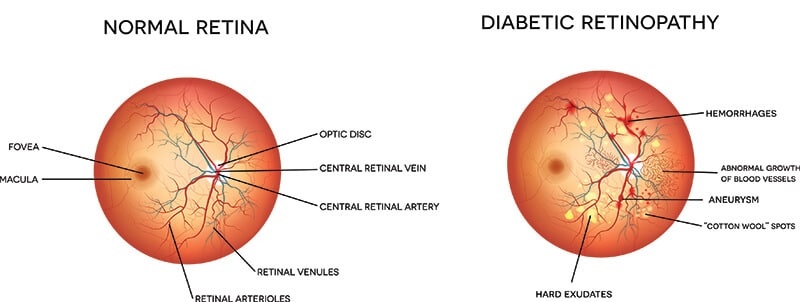Diabetic Eye Exams
Patients with diabetes are at an increased risk of developing eye diseases that can lead to vision loss and blindness, such as diabetic retinopathy, cataracts and glaucoma. In fact, diabetes is actually the leading cause of blindness in the United States.
Diabetic eye conditions often develop without any noticeable vision loss or pain, so significant damage may already be done to the eye by the time the patients notices any symptoms. For this reason, it is important for diabetic patients to have their eyes examined at least once a year. Early detection of eye disease can help prevent permanent damage.
Diabetic retinopathy is the most common type of eye disease related to Diabetes. Diabetic-related eye problems develop from high blood sugar levels, which can cause damage to blood vessels in the eye. Over 40 percent of diabetic patients will develop some form of eye disease in their life. The risk of developing eye problems can be reduced through regular eye exams and by keeping blood sugar levels under control through a healthy diet and regular exercise.
Diabetic eye conditions develop in the retina as a result of microvascular abnormalities. The tiny blood vessels within the retina become damaged and begin to leak blood. New blood vessels develop to try to get nutrients to the damaged area of the retina, but they can leak blood as well, causing hemorrhages and permanent damage to the retina.
Another complication that may occur is macular edema, or swelling in the center of the retina. The fragile vessels can easily leak fluid and cause severe vision loss or even blindness. The fluid can also leak into the center of the macula and cause swelling and blurred vision, a condition known as macular edema. The risk of developing macular edema increases as diabetic retinopathy progresses.
Treatment for early stages of diabetic retinopathy and other conditions usually focuses on maintaining levels of blood sugar, blood pressure and blood cholesterol, in order to prevent any permanent damage from occurring. For more advanced stages of the condition, laser surgery is often effective in shrinking the abnormal blood vessels.
Macular edema can also be treated through a laser procedure, called focal laser treatment, which places hundreds of laser burns in the area of retinal leakage to reduce the amount of fluid in the retina, or through injections with medications that shrink the leaky vessels.
Dr. Stancey refers patient that require laser treatment or injections for diabetic retinopathy to a retina specialist. It is important for patients to realize that these procedures cannot cure diabetic eye conditions, but rather help reduce vision loss for patients with advanced cases of the condition.





